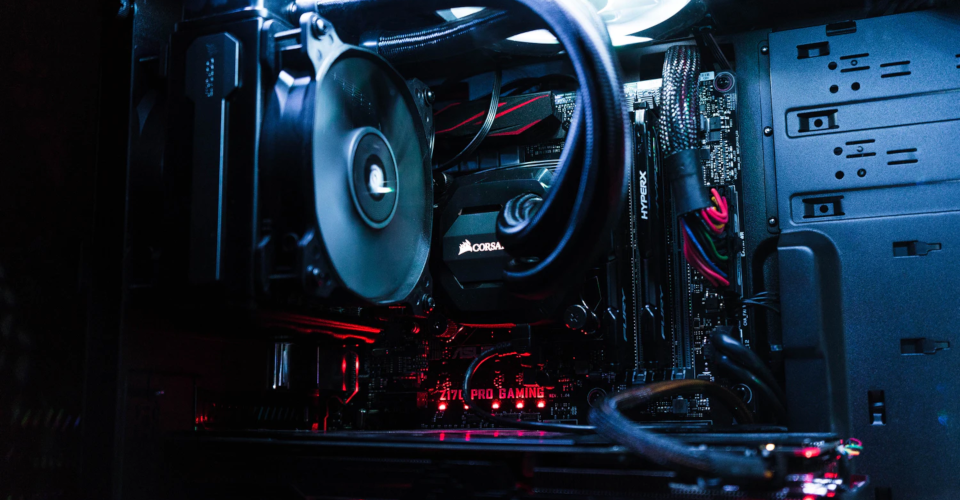6 Best Full Tower Case Picks for 2020
Using a full tower case in a high-end PC build is a must, especially if you plan on overclocking. The bigger, more spacious cases in this category feature more room between components and have space for more and more extensive cooling solutions. Both of these lead to significant drops in component temperatures, allowing you to push the CPU & GPU past their factory settings.
Large cases also make the installation of components easier since you don’t have to cram them in next to each other. They’ll take the longest graphics cards and will even let you run two at the same time. Some cases are even specifically designed to house two separate configurations. Cable management is less of a problem as well as there’s more room behind the motherboard for optimized routing.
Here are the six best full tower picks on the market. All of them are made to the highest standards and will protect any kind of setup you can think of from harm. Whether you need dozens of terabytes of storage or a system that will be able to run Cyberpunk 2077 on ultra in 4K, you’ll find the right case for the job here.
| Budget |
|---|
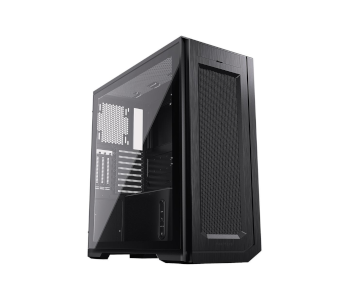 |
| Phanteks Enthoo Pro 2 |
| 4.5/5.0 |
| Dimensions: 22.8 x 9.4 x 22 in. |
| Weight: 28.7 lbs. |
| Supports impressive number of drives. |
| Check Newegg |
| Best Value |
|---|
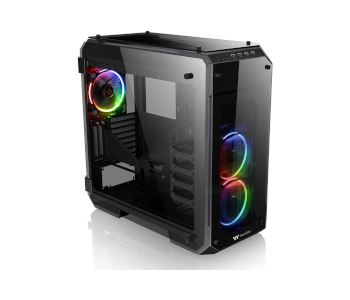 |
| Thermaltake View 71 |
| 4.6/5.0 |
| Dimensions: 23.3 x 10.8 x 22.7 in. |
| Weight: 41.7 lbs. |
| Drive bays can be removed or repositioned. |
| Check Amazon |
| Top Pick |
|---|
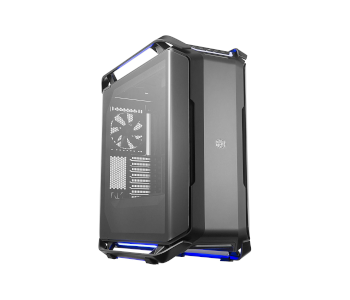 |
| Cooler Master Cosmos C700P |
| 4.8/5.0 |
| Dimensions: 25.6 x 12.1 x 25.2 in. |
| Weight: 48.9 lbs. |
| Exceptional build quality & finish. |
| Check Amazon |
Full Tower Cases Comparison Table
| Image | Product | Overall Rating | Build quality & aesthetics | Ports & cable management | Cooling | Price |
|---|---|---|---|---|---|---|
 | Cooler Master Cosmos C700P | 4.8 | 4.9 | 4.8 | 4.6 | Check Price |
 | Thermaltake View 71 | 4.6 | 4.7 | 4.5 | 4.5 | Check Price |
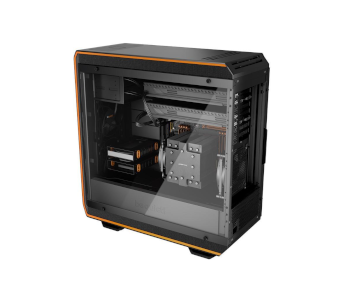 | be quiet! Dark Base Pro 900 Rev.2 | 4.6 | 4.6 | 4.6 | 4.7 | Check Price |
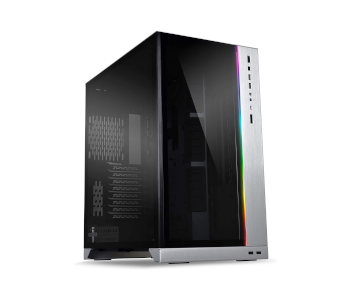 | Lian Li O11 Dynamic XL | 4.5 | 4.4 | 4.6 | 4.5 | Check Price |
 | Cougar Panzer Max | 4.4 | 4.4 | 4.4 | 4.5 | Check Price |
 | Phanteks Enthoo Pro 2 | 4.5 | 4.2 | 4.6 | 4.6 | Check Price |
1. Best Overall – Cooler Master Cosmos C700P
Editor’s Rating: 4.8/5
The Cosmos line of Cooler Master’s high-end cases was a staple in PC building back in the day, and the Cosmos C700P is the best possible reboot to do it justice. It’s a supremely modular case you can outfit with any PSU, motherboard, and cooling solution. It combines aesthetics and performance in one appealing package with the staying power to last through multiple system rebuilds.
Overview of Features
We love the Cosmos C700P’s industrial design full of edges and sharp angles. The tempered gas panel deserves special mention since it is angled. This is achieved through a process that reheats parts of the panel to bend them into shape, which puts tremendous stress on the glass and isn’t easy to pull off cleanly. The front cover is solid plastic and snaps off to reveal a protective mesh and two pre-installed 140mm fans.
The generous I/O ha four USB 3.0 and one USB Type-C slot along with fan speed and RGB controllers. The RGBs are strategically placed along the Cosmos C700P’s edges and unnoticeable while off. However, turning them on lights the entire case up in a spectacular display you might find distracting in a dark room.
The Cosmos C700P’s interior is made from excellent steel. Three panels shield the PPSU, drive bays, and cables from view to give the case a minimalistic and clean interior look. Removing them reveals ample room for any PSU you want to use and drive bays on rails that offer much room for repositioning. There’s also a motherboard tray you can take out and even rotate to make installing the motherboard easier.
There’s lots of room for thermal improvements since the Cosmos C700P can support nine 140mm fans. You can place three additional ones on top, two at the bottom, and another one in front. All fan locations also support the addition of radiators if you’re using liquid cooling. Dust buildup isn’t a problem since all but a mesh material protects all except the back fan. We particularly liked the one on the bottom. It spans the entirety of the Cosmos C700P’s length and can easily be removed by pulling it forward.
The Cosmos C700P is a decent case when it comes to noise and thermals out of the box, but there’s lots of room for improvement. One or two extra fans are enough to improve airflow considerably without impacting the noise, or the already considerable price.
What We Didn’t Like
The Cosmos C700P’s side panels open up like car doors and use magnets instead of screws. The magnets do a good job when the case is stationary, but you’ll want to secure the panels with something sturdier when moving it. This is the most expensive full tower on review.
| Tech Specs |
|---|
| Dimensions: 25.6 x 12.1 x 25.2 in. |
| Weight: 48.9 lbs. |
| Supported motherboards: Mini ITX – E-ATX |
| Expansion slots: 8 |
| Front connections: 4x USB 3.0, 1x USB Type-C, 3.5 mm audio & mic |
| Max. CPU cooler height: 7.8 in. |
| Max. GPU length: 12.6 in. with HD cage, 19.3 in. without |
| Internal bays: 2x 3.5” or 2.5”, 2x 2.5” |
| Installed fans: 2x 140 mm front, 1x 140mm rear |
| Pros |
|---|
| Exceptional build quality & finish |
| Modular and flexible |
| Ample room for any PSU and large graphics cards |
| Has excellent cooling potential |
| Cons |
|---|
| Expensive |
| Transport requires you to secure the side panels better |
2. Best Value – Thermaltake View 71
Editor’s Rating: 4.6/5
Are you looking for an accessible full tower case that will display your hardware in all its glory? In that case, there’s nothing better than Thermaltake’s View 71. A study in glass, this transparent case exposes every bit of your system while allowing for extensive air or water cooling setups. There’s a lot of room to work with, and you get all the accessories needed for effective cable management & painless installation.
Overview of Features
The View 71 takes the concept of using tempered glass in case design to a whole new level. Only its bottom and back are metal; the top and even the right-side panel are made from glass, for better or worse. It’s slightly tinted, but not so much that you couldn’t appreciate the build inside. Removing the panels is straightforward as thumb screws secure them. The ones on the side have hinges you can detach them from when you need room to make more involved adjustments to your system.
Installing the motherboard is intuitive since several sets of grommets correspond to sizes from Mini-ITX to E-ATX. You can mount the GPU using any of the eight expansion slots or attach the included extension and use the two other slots to display it vertically. Four drive bays close to the front hold a 3.5 or 2.5” disk each. You can slide them up and down the rails or remove them altogether to make more room for a longer graphics card or a radiator.
Speaking of which, the View 71 is equally well-suited for air and water cooling. The stock setup is mediocre since you get single front and back 140mm fans. You can put one more 140mm or three 120mm fans in front, three 140mm ones on top, and two 120mm fans on the bottom. Alternately, there’s space for 420mmradiators in the front, right, and top with additional room for a 140mm radiator in the back and a 240mm one on the bottom.
You’d think that a case with this much glass would have terrible thermals. While the View 71 isn’t the best-performing model when it comes to cooling, we have to give credit to Thermaltake for designing efficient temperature regulation considering its limitations. There’s some room between each penal and the case that provides enough air for the intake fans to do their job effectively.
What’s Bad About It?
The View 71 is tightly constructed; so tightly that this might pose a problem when removing its components. For example, the screws holding the drive bays are screwed in so tight that you’ll need to apply pressure carefully to not strip them. There’s no panel to conceal the cables, so your management skills need to be on point.
| Tech Specs |
|---|
| Dimensions: 23.3 x 10.8 x 22.7 in. |
| Weight: 41.7 lbs. |
| Supported motherboards: Mini ITX – E-ATX |
| Expansion slots: 8+2 |
| Front connections: 2x USB 3.0, 2x USB 2.0, 3.5 mm audio & mic |
| Max. CPU cooler height: 7.5 in. |
| Max. GPU length: 12.2 in. with HD cage, 16.1 in. without |
| Internal bays: 7x 3.5” or 10x 2.5” |
| Installed fans: 1x 140 mm front, 1x 140mm rear |
| Pros |
|---|
| Beautiful all-glass construction |
| Good thermals despite so much glass |
| Lots of room for radiators and additional fans |
| Drive bays can be removed or repositioned |
| Cons |
|---|
| Tight screws can strip if you aren’t careful |
| Cables are visible from the outside |
3. be quiet! Dark Base Pro 900 Rev.2
Editor’s Rating: 4.6/5
The original Dark Base Pro 900 was beloved by fans due to its silent operation and efficient space use. Its second revision keeps much of what made the original great while adding its own unique twist in the form of more modularity and a new PSU shroud. The case is quiet, efficient, and easily accommodates even exotic builds.
Overview of Features
Not much has changed in the Dark Base Pro 900’s outward appearance. It’s still slightly rounded and has a glass panel that takes up the entire left side. Be Quiet! offers the case in pure black, but we like the one with orange accents better. They’re unobtrusive while adding flare to an already appealing design. Examining the I/O reveals an array of ports along with an unusual addition – a QI charger. This lets you charge a phone wirelessly, provided it has the required technology.
Like the C700P the Dark Base Pro 900 has a removable motherboard tray that speeds up mobo and GPU installation. There’s no PSU bay, just a cover and plug you need to remove before installing the power supply. On the other hand, the Dark Base Pro 900 has a PSU shroud with several small top panels that houses a handful of drive bays. Two more accommodate 3.5” disk drives, and there are even two 5.25” ones under the I/O for DVD drive installation.
The Dark Base Pro 900’s backplate is solid metal so no one will judge your cable routing skills. It also has room for two 120mm fans that might be a tight fit considering the lack of room between it and the motherboard plate. The case comes with three SilentWings 3 fans that boast a max RPM of 1,600. They’re available as standalone options, so you can buy extras that perfectly match the case. You may place additional fans all throughout the case, and the top even supports a large 180mm model.
Are There Drawbacks?
The airflow in the SilentWings 3 is hampered by a solid top and bottom. This decreases cooling effectiveness as it limits air expulsion to the back. The shroud design makes it hard to replace the PSU, and installing fans or radiators on the case’s bottom limits the power supply’s length.
| Tech Specs |
|---|
| Dimensions: 23 x 9.6 x 22.7 in. |
| Weight: 31.7 lbs. |
| Supported motherboards: Mini ITX – E-ATX |
| Expansion slots: 8 |
| Front connections: 2x USB 3.0, 1x USB 2.0, 1x USB Type-C, 3.5 mm audio & mic, QI charger |
| Max. CPU cooler height: 7.3 in. |
| Max. GPU length: 12.7 in. with HD cage, 18.6 in. without |
| Internal bays: 2x 5.25” 5x 3.5” (2x 2.5” each)x 2.5” |
| Installed fans: 2x 140 mm front, 1x 140mm rear |
| Pros |
|---|
| Intuitive and modular design |
| Attractive, especially the orange version |
| Has a QI charger |
| Supports lots of storage |
| Cons |
|---|
| Mounting fans or radiators on the bottom limits PSU length |
| Solid top and bottom panels decrease airflow efficiency |
4. Lian Li O11 Dynamic XL
Editor’s Rating: 4.5/5
The cases we’ve talked about so far either favor air cooling or give liquid cooling equal priority. However, the follow-up to the original O11 Dynamic is a must for anyone who’s seriously into AIO. It’s engineered to support three 360mm radiators, has room for ten disk drives, and sports an innovative design brimming with small yet clever design details.
Overview of Features
The first thing you’ll notice about the O11 Dynamic XL is its geometric, glass-focused design. The side panel and most of the front panel is tempered glass, giving you a prime view of the case’s roomy and well-organized interior. The front plate’s right side is made from aluminum and holds tie I/O, complete with an RGB controller. Two USB 3.0 slots are in line with other controls, while two more are at the panel’s bottom.
You get to the O11 Dynamic XL’s insides by removing the top aluminum cover and the side panel. The layout is unusual since the PSU goes behind the motherboard. Speaking of which, the O11 Dynamic XL supports sizes up to E-ATX as standard but can accommodate EBB with an optional accessory. There are four hot-swappable drive bays along with six more for 2.5” SSDs you can secure with screws attached to rubberized holes.
The O11 Dynamic XL is ideal for liquid cooling. You can position 360mm radiators on the top, bottom, and behind the front panel. Dust buildup isn’t an issue since magnetized meshes stop it in its tracks. You could also use air cooling if you wanted to since there’s room for 120mm fans on all sides of the case or even 2x 140mm fans on top and in front.
The O11 Dynamic XL’s design promotes a pristine-looking interior. The drive bays and SSD mounting plates keep them out of sight, while a central space behind the motherboard is used for cable routing and can be sealed off with its own panel to hide the mess.
What We Didn’t Like
Glass is an integral part of the O11 Dynamic XL’s aesthetic, so it’s baffling that they didn’t use a quality version of it. Smudges appear instantly, and the glass scratches easily. You have an effective way of hiding the cables, but managing them is a different matter. Lian Li supplies a single Velcro strap, so you’ll have to buy more to get the wires under control.
| Tech Specs |
|---|
| Dimensions: 21.7 x 11.8 x 19.8 in. |
| Weight: 25.6 lbs. |
| Supported motherboards: Mini ITX – E-ATX |
| Expansion slots: 8+2 |
| Front connections: 2x USB 3.0, 1x USB Type-C, 3.5 mm audio & mic |
| Max. CPU cooler height: 4.2 in. |
| Max. GPU length: 11.3 in. |
| Internal bays: 6x 2.5”, 4x Hot-Swap 2.5/3.5” |
| Installed fans: None |
| Pros |
|---|
| Great build quality & finish |
| Modular and flexible |
| Ample room for any PSU and large graphics cards |
| Has excellent cooling potential |
| Cons |
|---|
| Glass is prone to smudging and scratches |
| Cable management could be better |
5. Cougar Panzer Max
Editor’s Rating: 4.4/5
Some full towers showcase the beastly tech inside; others, like the Panzer Max, want you to look in awe at the case itself. It’s an eye-catching model with a surprisingly simple interior that makes building a PC effortless. The case ticks all the right boxes and isn’t even all that expensive when compared to other entries on our list.
Overview of Features
True to its name, the Panzer Max is built like a tank. It’s unusual in that the edges protrude outward and are angled, giving it the illusion of having armor. A window on the left side panel offers a glimpse into the case’s interior, but it’s much smaller in proportion than those on other full tower models we’ve reviewed. Two large handles complete the ensemble and make it easy to transport the tower.
Cougar has built the Panzer Max with ease of installation in mind as it offers unrestricted access to all of its segments. Removing the panels and top is a matter of operating a few latches, while the expansion slots and drive bay brackets have thumbscrews perfect for toolless tinkering. The PSU occupies a central bottom position and can be screwed in two different ways, depending on which set of cutouts you want to use. Speaking of cutouts, the Panzer Max has a large one for the CPU fan, and more can be removed if you’re planning on installing an elaborate water cooling system.
You’ll have to install the motherboard the old-fashioned way, but the 2.5 and 3.5” drive bays slide out and back in seamlessly. Cable management won’t be a problem either since this is the case with the most space in the back. The I/O takes up a large portion of the front panel and has all the USB ports you’ll need. We were also pleasantly surprised by a headphone hook. It’s a plastic accessory you can mount on either side of the front panel that will keep headphone cables from tangling.
Stock fan options are decent as you get two 120mm front fans and one in the back. There’s enough space above the motherboard for a radiator, and even thick ones won’t obstruct airflow or make installation of other parts harder. The top has a segment towards the back that clearly indicates fan or radiator placement, but more can also be installed on the bottom.
What’s Bad About It?
The Panzer Max’s PSU shroud could use some improvement. It’s made from plastic and needs to be removed if you plan on installing liquid cooling in the front. You also have to squeeze the shroud together to release it, which can be awkward. Most bottom meshes slide out for cleaning, but the Panzer Max’s requires you to place the case on its side to reach it.
| Tech Specs |
|---|
| Dimensions: 24.1 x 10.4 x 24.1 in. |
| Weight: 8.9 lbs. |
| Supported motherboards: Mini ITX – E-ATX |
| Expansion slots: 8 |
| Front connections: 2x USB 3.0, 2x USB 2.0, 3.5 mm audio & mic |
| Max. CPU cooler height: 6.7 in. |
| Max. GPU length: 15.4 in. |
| Internal bays: 6x 3.5” or 2.5” |
| Installed fans: 2x 120 mm front, 1x 120mm rear |
| Pros |
|---|
| Sturdy build with cool-looking accents |
| Focus on ease of component installation |
| Straightforward panel removal thanks to latches |
| Lots of space above and behind the motherboard |
| Cons |
|---|
| Plastic and cumbersome PSU shroud |
| Cleaning bottom filter requires tipping the case to the side |
6. Best Budget Option – Phanteks Enthoo Pro 2
Editor’s Rating: 4.5/5
Our budget full tower case recommendation is another reinvention of a popular classic, the Enthoo Pro 2. It’s a unique entry since it’s the only one that supports dual system and successfully tackles numerous challenges associated with that feat. Phanteks didn’t cut many corners either, leaving us with an affordable, versatile, and well-made case.
Overview of Features
At first glance, the Enthoo Pro 2 is the most minimalistic-looking case on review. Its conventional box shape isn’t broken up by odd angles or bits that stick out, and the glass panel has a thicker bezel than most. Taking a closer look reveals that things aren’t as boring as that. For example, the front panel has a unique honeycomb pattern made from a woven material that helps collect dust while bringing some visual flare.
This is a dual-system case, meaning that its interior is designed to accommodate two motherboards, PSUs, and graphics cards. The main PSU slots into the bottom right part of the case vertically so its fan aligns with the side panel. This leaves enough room for the second ITX-sized motherboard that rests on the main PSU’s shroud. You’ll have to make some room for the other power supply if the main one can’t handle two systems and will have to install the second GPU vertically.
The Enthoo Pro 2 is a dream come true for users in need of lots of storage space. It comes with four 3.5” drive bays and has room for a jaw-dropping eleven 2.5” SSDs. You can lock them in place either with front-facing fan covers or tuck seven of them back behind the motherboard. Installing a second system or using water cooling will significantly reduce drive space, but you’ll still be left with three options in the worst-case scenario.
The Enthoo Pro 2 lacks any form of cooling. This is intentional since Phanteks posits that people willing to invest in a dual-system case will also want to outfit it with custom cooling solutions. Going for fans lets you install a maximum of fifteen 120mm or seven 140mm fans and have superior air cooling coming from all sides. AIO enthusiasts will benefit from the Enthoo Pro 2 as they can install two 480mm and as many 360mm radiators simultaneously.
Are There Drawbacks?
Taking full advantage of the case’s dual-system angle requires you to invest in Phanteks’ ecosystem further. The biggest culprit is the Revolt X, a special PSU designed with enough wattage to seamlessly power the entire computer that costs almost twice as much as the case. The I/O is unusual in that the restart button acts as the second system’s power button instead if two are active. It’s hidden behind a flimsy plastic cover you need to flip up every time you want to use a USB port or turn a system on.
| Tech Specs |
|---|
| Dimensions: 22.8 x 9.4 x 22 in. |
| Weight: 28.7 lbs. |
| Supported motherboards: Micro-ITX – E-ATX for main system, ITX for secondary system |
| Expansion slots: 8+3 |
| Front connections: 4x USB 3.0, 1x USB Type-C, combo audio & mic |
| Max. CPU cooler height: 7.7 in. |
| Max. GPU length: 19.8 in. |
| Internal bays: 4x 3.5” or 2.5”, 11×2.5” |
| Installed fans: None |
| Pros |
|---|
| Has enough room for two computer configurations |
| Superb airflow or water cooling potential |
| Supports impressive number of drives |
| Woven front mesh is both decorative and useful at keeping dust at bay |
| Cons |
|---|
| Dual-system setup works best with expensive proprietary PSUs |
| Annoying I/O cover |
Contents
- Full Tower Cases Comparison Table
- 1. Best Overall – Cooler Master Cosmos C700P
- Overview of Features
- What We Didn’t Like
- 2. Best Value – Thermaltake View 71
- Overview of Features
- What’s Bad About It?
- 3. be quiet! Dark Base Pro 900 Rev.2
- Overview of Features
- Are There Drawbacks?
- 4. Lian Li O11 Dynamic XL
- Overview of Features
- What We Didn’t Like
- 5. Cougar Panzer Max
- Overview of Features
- What’s Bad About It?
- 6. Best Budget Option – Phanteks Enthoo Pro 2
- Overview of Features
- Are There Drawbacks?

